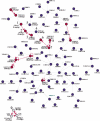Identification of potential interaction networks using sequence-based searches for conserved protein-protein interactions or "interologs"
- PMID: 11731503
- PMCID: PMC311221
- DOI: 10.1101/gr.205301
Identification of potential interaction networks using sequence-based searches for conserved protein-protein interactions or "interologs"
Abstract
Protein interaction maps have provided insight into the relationships among the predicted proteins of model organisms for which a genome sequence is available. These maps have been useful in generating potential interaction networks, which have confirmed the existence of known complexes and pathways and have suggested the existence of new complexes and or crosstalk between previously unlinked pathways. However, the generation of such maps is costly and labor intensive. Here, we investigate the extent to which a protein interaction map generated in one species can be used to predict interactions in another species.
Figures




References
-
- Du W, Vidal M, Xie J-E, Dyson N. RBF, a novel RB-related gene that regulates E2F activity and interacts with cyclin E in Drosophila. Genes & Dev. 1996;10:1206–1218. - PubMed
-
- Endoh H, Walhout AJM, Vidal M. GFP-reverse two-hybrid system: Application to the characterization of large numbers of potential protein-protein interactions. Methods Enzymol. 2000;328:74–88. - PubMed
-
- Endoh, H., Vincent, S., Jacob, Y., Réal, E., Walhout, A.J.M., and Vidal, M. An integrated version of the reverse two-hybrid system for the “post-proteomic” era. Methods Enzymol. in press. - PubMed
-
- Flajolet M, Rotondo G, Daviet L, Bergametti F, Inchausp G, Tiollais P, Transy C, Legrain P. A genomic approach of the hepatitis C virus generates a protein interaction map. Gene. 2000;242:369–379. - PubMed
Publication types
MeSH terms
Substances
Grants and funding
LinkOut - more resources
Full Text Sources
Molecular Biology Databases
